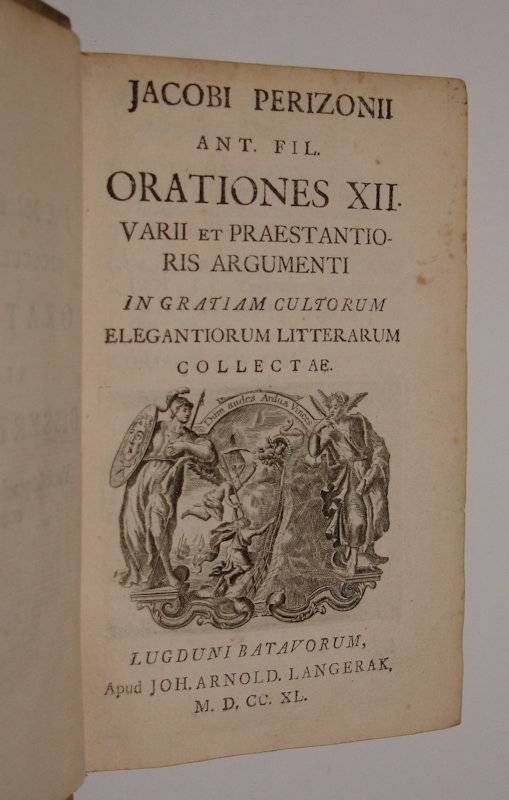PERIZONIUS,J.
Jacobi Perizonii Ant. Fil. Orationes XII, varii et praestantioris argumenti in gratiam cultorum elegantiorum litterarum collectae,
Leiden (Lugdini Batavorum), Apud Joh. Arnold Langerak, 1740.
8vo. XXXVIII,592 p. Vellum 17 cm (
Details: 5 thongs laced through the joints. Engraved printer's mark on the title, it depicts a man who is busy climing a steep hill; a winged diety, Father Time (Tempus), who sways his scythe and has an hourglass on his head, helps him to ascend; at the top of the hill rests a huge cornucopia; this scene is flanked Athena and the Muse Clio (?), whose head is winged and who has scroll and quill at hand; the motto reads: 'Dum audes, ardua vinces', 'You will be succesful daring') (
Condition: Vellum age-toned. Both pastedowns slightly stained. Small paper label on the back) (
Note: The Dutch ancient historian Jacobus Perizonius, 1651-1715, was professor of History at the University of Franeker from 1682, and from 1693 of Leiden. His historical work broke new ground, and may be said to have laid the foundations of historical criticism. It anticipates Niebuhr's method of dealing with the early history of Rome. He made his name with his 'Animadversiones historicae' (1685), which work is recognised as a masterpiece of historical criticism. 'In his 'Origines Babylonicae et Aegypticae (1711), he was the first to suggest the spuriousness of the royal list of Manetho, and he defended the chronology of Scaliger'. (J.E. Sandys, 'A history of classical scholarship', New York 1964, volume 2, p. 331) Perizonius wrote also a learned dissertation on Dictys (1702). His merit as a philologist is demonstrated in his commentary on the 'Minerva' of Sanctius, which became a standard (1687, 1693, 1702, 1704, 1714, 1733, 1752, 1754, 1789, 1793, 1795 & 1809), and his edition of the 'Variae Historiae' , a miscellany of the late antique author Aelianus (1701).
§ From the dedication at the beginning of this book, dated Zaltbommel 1739, we learn that F.G. Westerhovius is the editor of this collection of speeches of Jacob Perizonius, 'praeceptoris quondam mei amantissimi'. Westerhovius studied probably under Perizonius at the University of Leiden, where Perizonius lectured from 1693. Frederik Wilhelm Westerhovius, was born in 1675, and was appointed rector of the Schola Latina at Gorichem, and later (still alive in 1742) Zaltbommel. Westerhovius added after the 'dedicatio' a 7 page biographical sketch (Viri Clarissimi Jacobi Perizonii vita) of his admired professor, and a list of 12 pages (Codices quos Bibliothecae legavit Clarissimus Jacobus Perizonius) listing the 38 manuscripts, among which one of the 10th century, and 59 valuable (post)incunabula Perizonius bequaethed to the Library of the University of Leiden. The collection of orations opens with Perizonius's inaugural lecture held at Franeker 'De Ciceronis industria' (1682), and his inaugural lecture of Leiden 'De usu Graecae Romanaeque linguae' (1693). Follow 'De Pyrrhonismo historico', 'De doctrinae studiis nuper cultis', 'De origine et natura Imperii', 'De bello contra Gallos et Hispanos', 'De Aethere Britannis & Batavis militante', 'De facta nuper pace', 'Cum Vilhelmus & Maria coronarentur', 'Funebris Mariae Reginae', 'In obitum Abrahami Gravii') (
Provenance: From the library of Caspar Reuvens and with his library ticket on the spine. Caspar Jacob Christiaan Reuvens, 1793-1835, was a Dutch historian and archaeologist. He was the founding director of the Rijksmuseum van Oudheden (Dutch National Museum of Antiquities) in Leiden, the world's first ever professor of archaeology at Leiden University, and conducted the first excavations at the Roman provincial site Forum Hadriani in the Netherlands'. (See English Wikipedia, with his portrait) On the verso of the front flyleaf has been attached a small leaflet, format visiting card, with the text: 'Jacob Perizonius wenscht mijn geachte Buurman in de Veenlaan te 's Gravenhage, een gelukzalig jaar van 1867'. On the backside of this: 'Dr. Wap en echtgenoot, 1 januari 1867 (met een boekgeschenk)'. Perizonius is here used as the messenger of the New Year's wishes of Doctor Johannes Jacobus Franciscus Wap to one of his neighbours. The Dutchman Jan Wap, 1806-1880, was in the 19th century a wellknown man of letters. The city of The Hague honoured him by naming a street after him, the Jan Wapstraat. Wap was living at the time at the Veenkade number 14. The Veenkade (nowadays Toussaintkade), a row of houses for well to do citizens, was part of the canal system (singel) which went round the city untill the end of the 19th century) (
Collation: *-2*8, 3*4 (minus leaf 3*4), A-2O8) (leaf L5 signed M5; leaf 2H6 signed 2H5) (Photographs on request)
Book number: 120119 Euro 360.00
Keywords: (Oude Druk), (Rare Books), Aelianus, Cicero, Dutch history, Roman history, antike altertum antiquity, catbiografie, niederländische Geschichte, römische Geschichte
 PERIZONIUS,J.
PERIZONIUS,J.